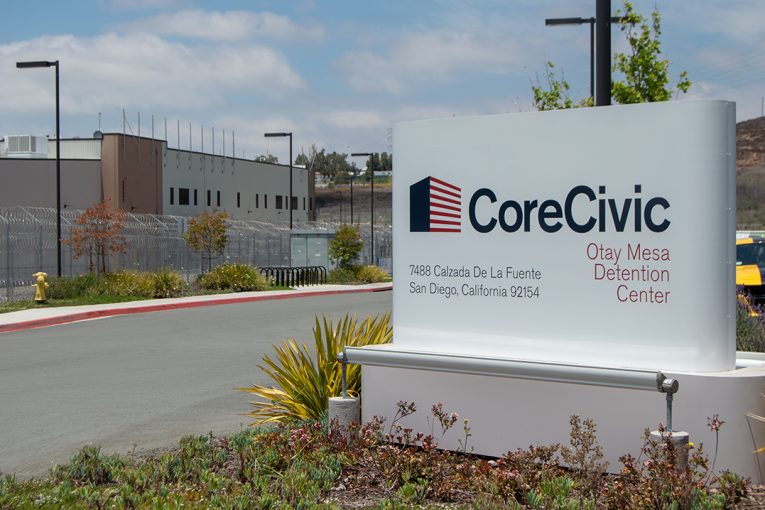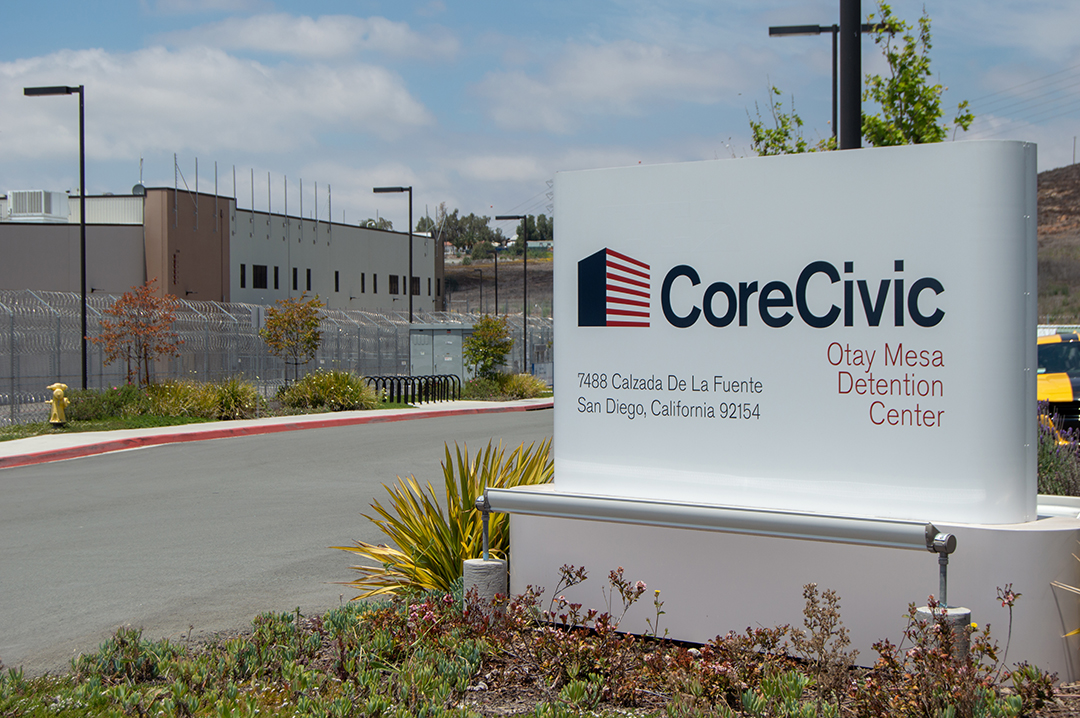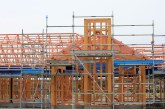

People incarcerated in the Otay Mesa Detention Center decry crowded units and substandard medical care as COVID-19 tears through the facility.
By Chris Gelardi
A Honduran asylum seeker, finding it difficult to breathe, had to wait hours to see a doctor, resulting in a panic attack. A group of women demanding protective equipment was met with threats of pepper spray. A man who tested positive for COVID-19 was sent to recover in an isolation cell where the lights were kept on 24 hours a day, making sleep impossible. A man with HIV was incarcerated for weeks in a unit with over 100 others, waiting to catch a virus that could kill him.
In court documents, news reports, and through their attorneys, people held in Otay Mesa Detention Center near San Diego describe scenes of distress and confusion as COVID-19 rips through the federal facility. They and their advocates say detention center officials and government agencies are employing reckless, abusive practices during the worst pandemic in over a century.
Operated by CoreCivic, a private prison contractor, Otay Mesa currently houses roughly 660 ICE detainees and around 300 from the U.S. Marshals Service. The facility has emerged as the clear epicenter of COVID-19 in immigration detention and a hotspot in the federal system: nearly one in five positive tests among ICE detainees come from Otay Mesa.
“It’s not hyperbolic to say that this is a matter of life or death,” said Monika Langarica, immigrant rights staff attorney with the American Civil Liberties Union of San Diego and Imperial Counties. “People’s lives, community health, public safety all depend on [ICE] acting responsibly right now.”
On April 22, a Marshals detainee in quarantine at Otay Mesa sent an email to her lawyer—who shared the message with The Appeal—that said only those with high fevers are getting tested. “From what my [symptoms] are the doctor said I have the virus but since I dont have a fever higher than 104 they wont test me,” wrote the woman, whose lawyer asked that she not be named because of her ongoing criminal  trial. She said she was being housed with women with severe coughs “but not a high fever, so medical is doing nothing for them.”
trial. She said she was being housed with women with severe coughs “but not a high fever, so medical is doing nothing for them.”
Anecdotes like this have led advocates to believe that the number of COVID-19 cases in Otay Mesa—and in federal detention in general—is much higher than official numbers indicate. Comprehensive testing efforts in some state prisons have revealed an alarming number of asymptomatic cases, prompting concerns that the virus spreads among incarcerated populations more quickly than officials realize, while new modeling from the Government Accountability Project predicts that 72 to nearly 100 percent of ICE detainees will be infected within 90 days. ICE reported on Tuesday that 124 of its detainees and 10 of its employees at Otay Mesa had tested positive, and press reports indicate that at least 66 Marshals detainees at the facility have contracted the virus.
ICE has also reported that a total of 674 of its detainees across the country have tested positive for the novel coronavirus. But ICE has tested less than 1,400 of the at least 38,000 people it has held in its custody since the outbreak, and half of those tested were positive—compared to about 16 percent nationwide. ICE did not respond to The Appeal’s questions.
“We are scared and hope something can be done for us,” the woman in Marshals detention wrote.
Otay Mesa—and its predecessor, CoreCivic’s San Diego Correctional Facility—has an extensive history of medical neglect allegations. In 2010, ICE settled a lawsuit filed by the ACLU that claimed that the correctional facility routinely denied detainees procedures as important as heart surgeries and cancer biopsies because it designated them as “non-emergency” treatment. As part of the settlement, CoreCivic pledged to reform its healthcare to meet or exceed national correctional standards. But reports of ignored pleas for medical attention leading to harm—including miscarriages and death from pneumonia and heart attacks—still surface regularly.
In the month since COVID-19 reached Otay Mesa, the facility has continued to earn its reputation. Lawsuits, press reports, and anecdotes from those on the inside describe a detention center seemingly uninterested in protecting its detainees and workers.
The first person confirmed to have COVID-19 inside the facility went into quarantine April 1—though the staff didn’t inform detainees until two days later, prompting the first of several threats to hunger strike. After that, the virus quickly spread.
Among the earliest confirmed cases was a man seeking asylum from Honduras. In a court declaration, he describes how, when he began to feel fatigue, chills, and a fever, a nurse gave him allergy pills and sent him back to a cell with eight other men, many of whom were also experiencing typical COVID-19 symptoms. After four days, he was too weak to stand up for a head count, so he was sent to a medical unit to get tested and await results. Four days later, before the results had come back, it became extremely difficult for him to breathe. His cellmate in the medical unit had to bang on the door for more than two hours before staff members arrived to take him to see a doctor, according to the declaration. The doctor sent him to the emergency room.
Anxiety over cases like the Honduran man’s quickly spread throughout Otay Mesa, and those incarcerated in the facility began to complain of a lack of protective equipment. When a shipment of surgical masks arrived at the detention center on April 10, staff members handed detainees copies of a contract—written only in English—absolving CoreCivic of liability “related directly to [their] wearing of the face mask,” according to the San Diego Union-Tribune. Women in one immigration unit refused to sign the contracts and threatened a hunger strike, to which they say officers responded by threatening to pepper spray them. A call from inside the unit, recorded by immigrant rights group Pueblo Sin Fronteras, suggests that some officers responded to detainee objections with force.
“On April 10, there was no use of force at Otay Mesa Detention Center,” asserted Amanda Gilchrist, CoreCivic’s director of public affairs. She assured The Appeal that there is an adequate supply of face masks, as well as soap and cleaner, and that “no waiver will be required to receive a mask.”
After hearing about the initial shortage of masks—as well as some complaints from detainees’ relatives that the detention center frequently ran out of soap—Lorena Gonzalez, a state assembly member representing Otay Mesa’s district, teamed up with local organizations to gather about 1,000 masks to donate to the facility. But when she arrived at the detention center, the staff wouldn’t let her in. Gonzalez told The Appeal that, when she finally got hold of the warden, Christopher LaRose, he told her that there were plenty of masks and soap to go around. When she asked to tour the facility, LaRose said she would have to make that request with ICE.
“We don’t know what [detainees] are being left with,” Gonzalez said. “But we do know that the COVID-19 virus is spreading throughout the facility, and that they have a record number of positive cases. So something’s not being done right.”
Medical professionals and advocates say the best way to prevent the spread of COVID-19 among incarcerated populations is to release as many people as possible, because it reduces crowding and makes it easier for people to isolate. Many ICE detainees are incarcerated only because they’re waiting to get in front of an immigration judge for an asylum hearing. But ICE and the Marshals have still resisted releasing medically vulnerable people, so lawyers have been filing lawsuits to compel them to do so.
The largest litigation efforts have come from the ACLU of San Diego and Imperial Counties, which has filed two class-action suits—one against ICE and one against the Marshals. Both suits have asked a federal court to compel the agencies to release all people over the age of 45—plus those with underlying medical conditions that make them especially vulnerable to COVID-19—from Otay Mesa and the nearby Imperial Regional Detention Facility.
While detention during a pandemic is dangerous on its face, the ACLU lawsuits argue that ICE and the Marshals’ coronavirus mitigation plans are severely lacking. “I am unaware of any epidemiologist or any public health expert who would consider [ICE’s] procedures to be sufficient preventative measures,” Joseph Amon, a clinical professor of community health at Drexel University, wrote in a court declaration. The Marshals, he wrote, are even more unprepared: The service “does not appear to have any plan to establish special protections for high-risk patients.”
And ICE seems to be offering little justification for its reluctance to release detainees, making legal challenges exceedingly cumbersome.
“Their arguments are ridiculous. It’s shocking,” said Munmeeth Soni, director of litigation and advocacy at the Immigrant Defenders Law Center, who is representing four Otay Mesa detainees trying to get released. “It seems that this agency is in a state of denial about what COVID is, what measures need to be taken to protect from COVID, and that the people that are in their custody are somehow not in danger from COVID.”
The two class-action suits use a template that lawyers around the country have been following in their attempts to get clients released: first, a complaint alleging that detention during the pandemic violates constitutional due process and protections against cruel and unusual punishment, then, a motion for a temporary restraining order that would, if successful, secure detainees’ release during the possibly months-long litigation process.
On April 30, the District Court for the Southern District of California granted a version of the ACLU’s temporary restraining order motion in the ICE lawsuit, ordering ICE to release a subclass of detainees who are over 60 or “who have medical conditions that place them at heightened risk of severe illness or death from COVID-19.” But on Monday, LaRose, the Otay Mesa warden, rebutted; after claiming that more than 50 ICE detainees fit the subclass’s parameters, he asked the judge to reconsider the order, taking issue with, among other things, the ACLU’s charge that conditions inside the detention center violate detainees’ constitutional rights. According to the ACLU, ICE has continued to process people for release, despite LaRose’s challenge—though only two had been released as of Monday.
In addition to the ACLU’s class-action suits, The Appeal has identified nine other lawsuits against Otay Mesa and its government agency partners—filed between late March and late April in the District Court for the Southern District of California—all of which employ the same basic legal framework. Despite the ACLU’s relative success, these cases show that, even with a motion for a temporary restraining order, it can take weeks for a judge to issue a decision that results in detainees’ release, and success is far from guaranteed. Two of the suits were dismissed because ICE paroled the plaintiffs on its own. Of the other seven, two were denied in their entirety, one has had its motion for a temporary restraining order denied, and the rest are still in early stages of litigation.
Additionally, last week, two detention officers at Otay Mesa filed lawsuits against CoreCivic, charging that the company has failed to protect their health amid the pandemic.
Many lawyers are frustrated that they have to file so many slow-moving, unpredictable lawsuits and just want the government to ensure their clients’ safety.
“We’ve tried to get them bonds, secure their release through the immigration courts, and we’re being shut out everywhere,” said Soni of the Immigrant Defenders Law Center. One of her clients, a 33-year-old asylum seeker from Nicaragua, tested positive for COVID-19, and was sent to an isolation cell, where the lights were kept on for 24 hours a day, making it impossible for him to sleep and recover, according to court records. (The Immigrant Defenders Law Center asked that The Appeal withhold the names of its plaintiffs given the dangers they face in their home countries and the high rate of asylum denial among San Diego immigration judges.)
“ICE has the discretion to release anyone from its custody at any moment,” said Langarica, one of the ACLU of San Diego attorneys on the class-action case against ICE. Her lead named plaintiff, Adrián Rodríguez Alcántara, who is at severely heightened risk of succumbing to COVID-19 because of his HIV-positive status, was “cohorted” in a unit with over 100 men, and claims that he is unsure that CoreCivic adequately managed his HIV treatment.
“There’s just been a real refusal to do what public health and medical experts are calling for,” Langarica said.
Update: At around 2:15 a.m. Wednesday, 57-year-old Carlos Ernesto Escobar Mejia, an ICE detainee at the Otay Mesa Detention Center, died of COVID-19, according to the San Diego Union-Tribune. He had been in the hospital for more than a week. On April 15, an immigration judge denied him bond, but at the time of his death, he was on a list of medically vulnerable detainees at Otay Mesa under consideration for release as part of a class-action lawsuit. Escobar Mejia had lived in the United States since 1980, having fled civil war in El Salvador, and was the only one of five siblings not to receive legal permanent residency. He’s the first known person to die of COVID-19 while in ICE custody.
Article originally posted on the Appeal
To sign up for our new newsletter – Everyday Injustice – https://tinyurl.com/yyultcf9






I wonder what happened to “safe and sanitary”?